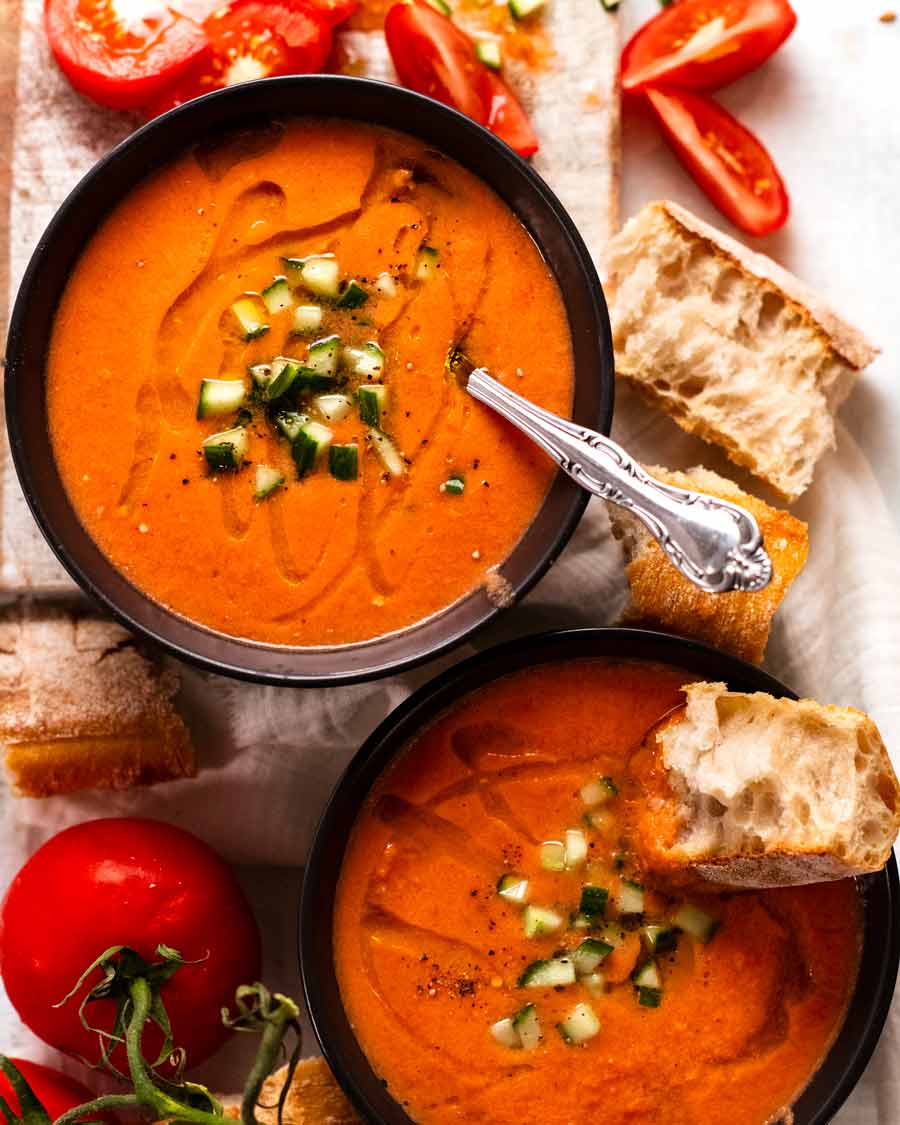
If the thought of this cold Spanish soup conjures up visions of watery, bland, pureed vegetables, think again! The secret to a really good Gazpacho is marinating ripe vegetables with vinegar, olive oil and garlic. Fabulous, refreshing summer food bursting with flavour. No cook!

Gazpacho – chilled Spanish soup
I tell people gazpacho is like salsa in soup form. But instead of using corn chips for scooping, you get to dunk chunks of crusty bread into that bowl of tasty goodness.
The fact that it’s good-for-you doesn’t even cross your mind. All you know is that once you start, you don’t want to stop. And if you’re eating this on your deck on a hot summer day? I WANT TO BE YOU! (Especially if you have a cold glass of wine on the side….)

What you need to make gazpacho
Traditionally, gazpacho includes bread for thickening the soup and keep leftovers from splitting if you leave it overnight. I find the soup is plenty thick enough without bread. As for splitting? Just stir once – maybe twice – and it’s back to the original state.
So – my recipe has no bread! (Bonus: means it’s gluten free and virtually carb free.)
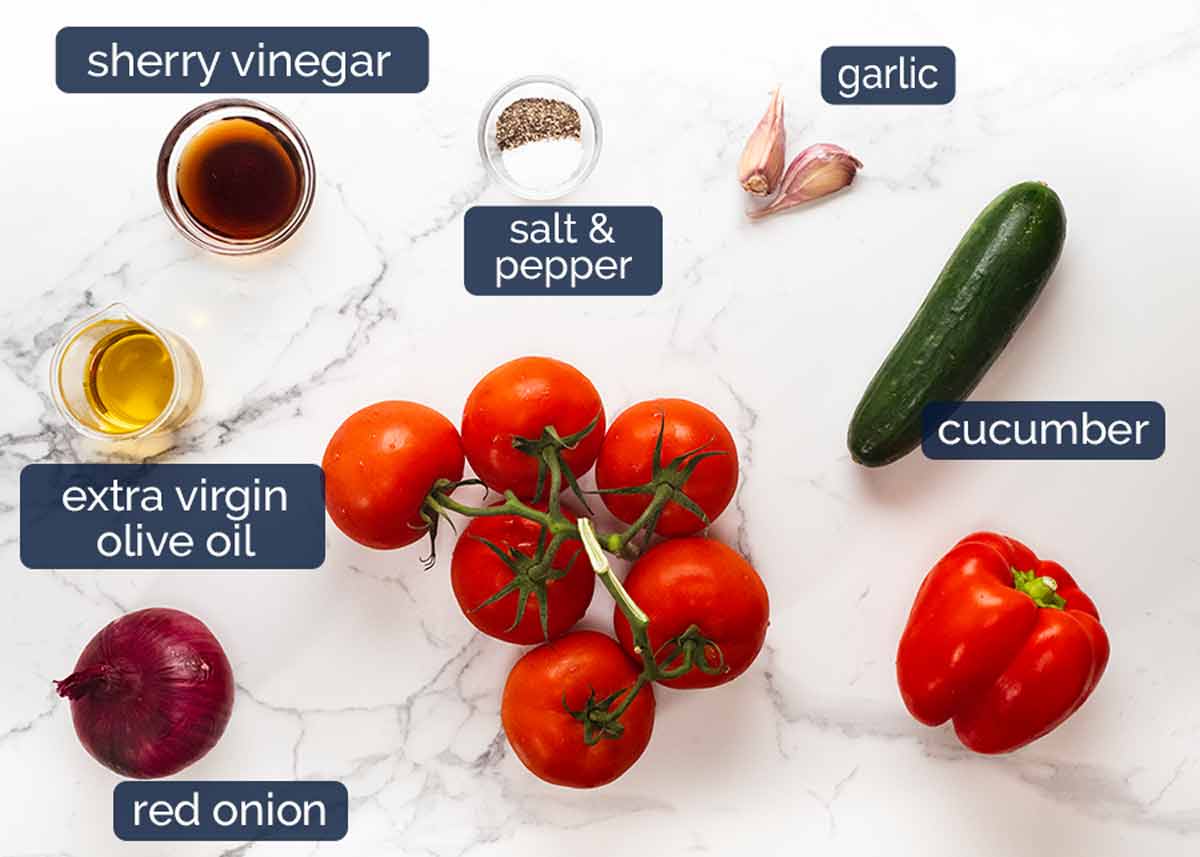
Tomatoes – As the primary ingredient in gazpacho, getting juicy ripe ones is key to great flavour here! Don’t be tempted to substitute with canned tomato. It just won’t be the same.
Cucumber – One cucumber around 20cm/8″ long. I like to peel it to preserve the reddish colour of this soup and also it makes the soup smoother. But, you can leave it on it you wish. Extra nutrition! Just expect slightly more texture in your soup as it won’t puree fully.
Red capsicum / bell pepper – Traditionally. Spanish gazpacho is more frequently made with green rather than red capsicum / bell pepper. I like to use red for colour consistency and also because red capsicum is slightly sweeter than green (which is actually just un-ripened red capsicum!).
-
Red onion – You’ll only need about 1/4 of a red onion as we need 1/4 cup of chopped red onion. I don’t usually measure red onion in cups but in this no-cook soup, if you use too much then it’s too onion-y. And if you don’t use enough, you lack the fresh zing.
So – chop. Then measure 1/4 cup!
Garlic – Gazpacho is not gazpacho without the delicious flavour garlic brings to it!
-
Sherry vinegar – This is the vinegar that is traditionally used in gazpacho. It’s made from sherry and has more flavour than common plain white vinegar.
Quality – The more you pay, the better the quality. The vinegar will be aged which means it has more flavour than economical brands. Such is the secret of why simple salads at fine dining restaurants are so good! Use what suits your budget. I reserve my 25 year Pedro Ximenez Sherry Vinegar for special occasion salads. I use Chef’s Choice or Moro for everyday purposes and recipe development.
Substitute with white wine vinegar, red wine vinegar or champagne vinegar. Apple cider vinegar will also work but a wee bit sharper.
Extra virgin olive oil – As with the sherry vinegar, the more you pay, the better the quality.
 Lomondo is an Australian extra virgin olive oil which I use as my “good olive oil”, though I always enjoy trying local varieties wherever I travel.
Lomondo is an Australian extra virgin olive oil which I use as my “good olive oil”, though I always enjoy trying local varieties wherever I travel. Salt and pepper – The only seasoning required for this wonderful refreshing dish!
How to make gazpacho
Authenticity note: Marinating the vegetables isn’t a step in traditional gazpacho recipes. But it does improve the flavour so it’s a recommended step, especially if you are using an economical vinegar or if your tomatoes aren’t farm-fresh-organic-ridiculously-ripe-and-sweet. That would be tomatoes sold in everyday Australian grocery stores, even at the height of summer. 
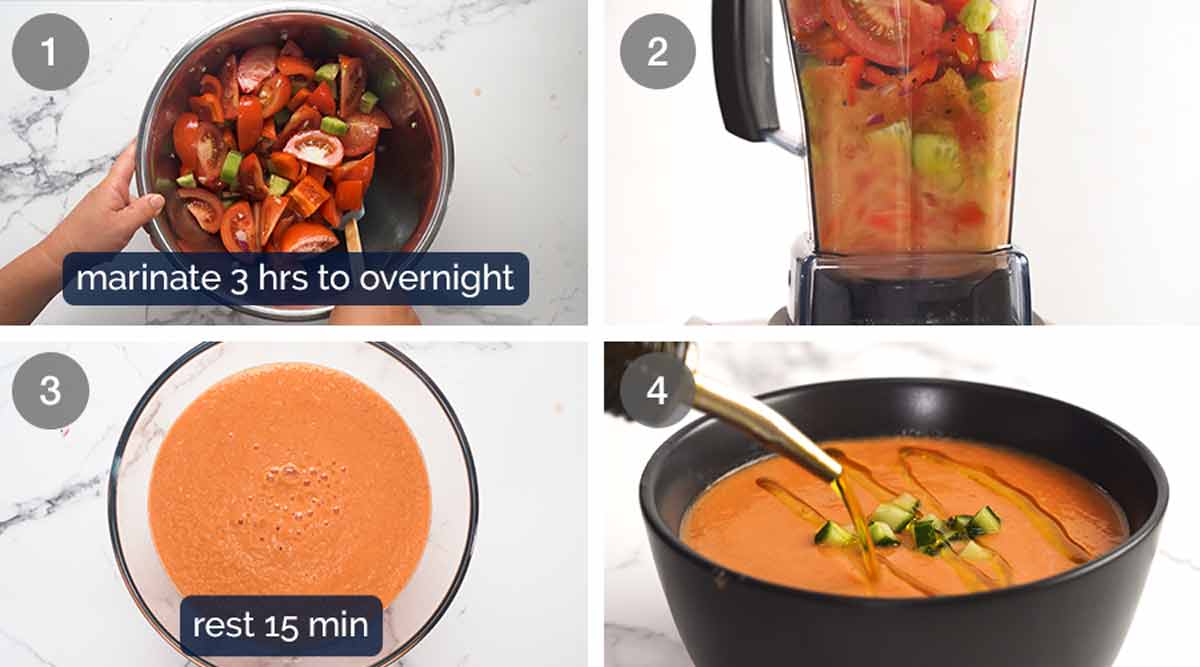
-
Marinate – Toss all the vegetables with the garlic, vinegar, olive oil, salt and pepper. Then set aside to marinate, preferably overnight (12 hrs up to 24 hours) or at least 3 hours. This allows the flavours to meld together more and the vinegar flavour smooths out as well. It really does make a noticeable difference.
However, if you don’t have time, it’s fine! Just proceed to the next step immediately. I do like to add an extra glug of olive oil when I don’t marinate, just to compensate.

-
Blitz! Transfer everything into a blender and puree until smooth. If you have a powerful one like a Vitamix or Blendtec then it will only take around 45 seconds on speed 7 or so. If yours is not as powerful then it may take a little longer.
Handheld blender stick also works but takes a little longer. Use a tall jug and work in batches, if need be. A food processor will get 90% of the way there but I find it doesn’t make it quite as smooth.
Smoothness note – If you’d like yours 100% smooth and thinner, more like a drink than a soup, then pass it through a very fine mesh or food mill. Discard the solids.
I like mine straight out of the blender which has a bit of texture to it, not 100% smooth, and a bit thick. Reminds me I’m eating a meal, not sipping a drink!
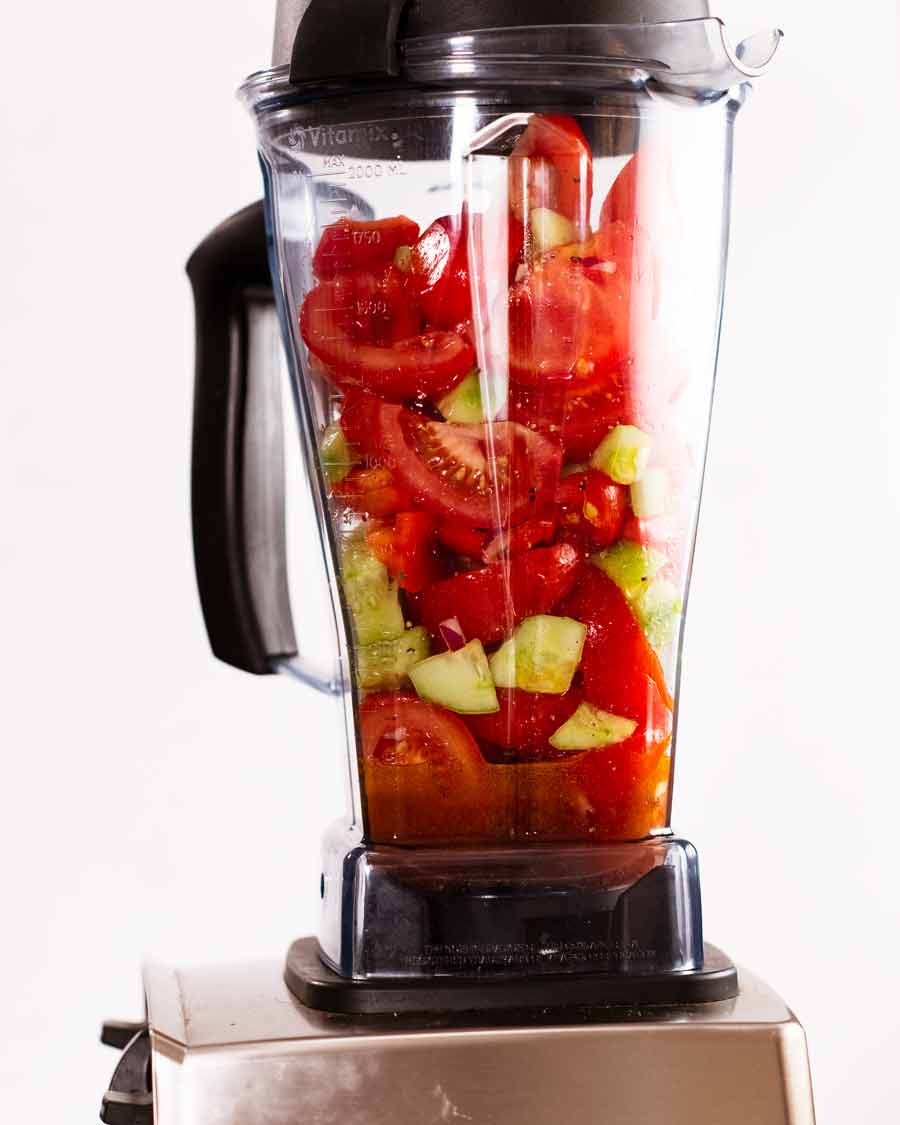
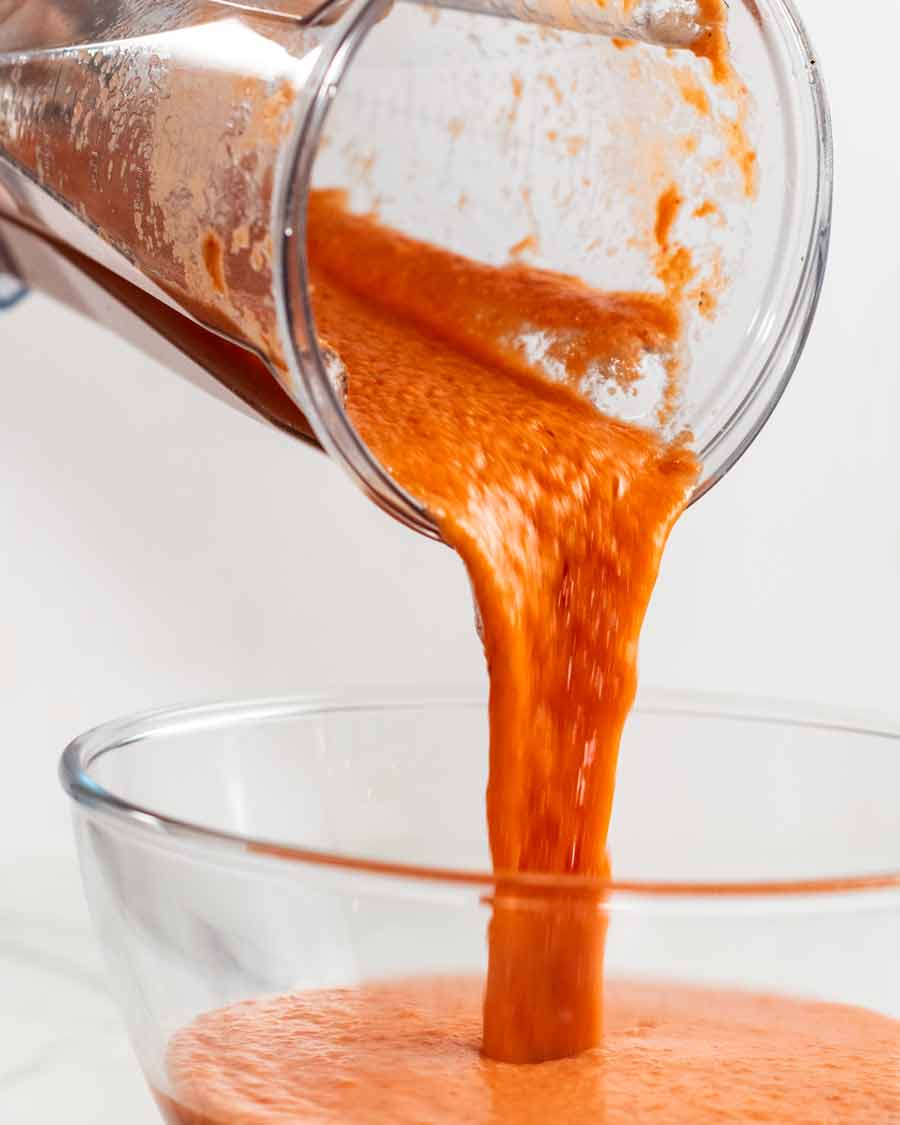
-
Rest – Pour the soup into a bowl and let it rest for 15 minutes. This allows the aeration incorporated into the soup when you blended it to settle a bit (so you don’t feel like you’re eating a mouthful of foam) and the colour will change slightly from orange to a slightly darker orange.
Wait, gazpacho isn’t red? Nope, it’s actually not! It’s more of a burnt orange colour.

-
Serve – Ladle into bowls and serve. Sometimes I top with little diced cubes of cucumber, for colour / texture / healthy garnish. I always finish with a swish of olive oil and pinch of pepper.
I like to serve gazpacho with crusty white bread for dunking. Both for the eating experience, and to bulk out the meal.

This gazpacho truly is seriously delicious. I’m not sharing this as diet food – low-carb, low-calorie, low-sugar food, high nutrition, etc etc.
It’s just a downright good food. Regular readers know I’m not a health-food website. I will never sacrifice tastiness for the sake of reducing calories. I just can’t. I enjoy food too much!
But I do believe in eating a balanced diet, and I do get extra excited when I can share a really great recipe that happens to be healthy.
Gazpacho ticks those boxes. 50 million Spaniards can’t be wrong!  – Nagi x
– Nagi x
Watch how to make it

Gazpacho
Ingredients
Gazpacho:
- 1 kg / 2 lb ripe tomatoes (~7), cut into 8 wedges, core removed
- 1 cucumber (20cm/8" long) , peeled and diced into 1cm / 1/2" cubes
- 1 red capsicum/bell pepper , cut into 1.5 cm / 1/2″ cubes
- 2 garlic cloves , chopped
- 1/4 cup red onion , finely diced (Note 1)
- 1/4 cup extra virgin olive oil , + extra for serving
- 1 1/2 tbsp sherry vinegar (sub white wine or champagne vinegar)
- 3/4 tsp cooking/kosher salt
- 1/2 tsp black pepper
Serving:
- Crusty bread
- Cucumber , cut into small cubes (optional)
Instructions
- Marinate – Toss all the gazpacho ingredients together in a large bowl. Cover then set aside to marinate, preferably 12 to 24 hours, or at least 3 hours. (Note 3)
- Blitz – Transfer everything into a blender and blitz on high until smooth. (Or use a tall jug with a hand blender). For 100% perfectly smooth, pass through a fine mesh strainer or food mill and discard solids (Note 2)
- Serve – Pour into a bowl. Rest for 15 minutes to let the bubbles subside. Stir, then ladle into bowls.
- Garnish – Top with diced cucumber, if using, and a swish of olive oil. Serve with crusty bread!
Notes
Nutrition
Life of Dozer
Dozer’s mates!! He wants to join the party but it’s a bit too cosy in there. 😂


The post Gazpacho appeared first on RecipeTin Eats.
